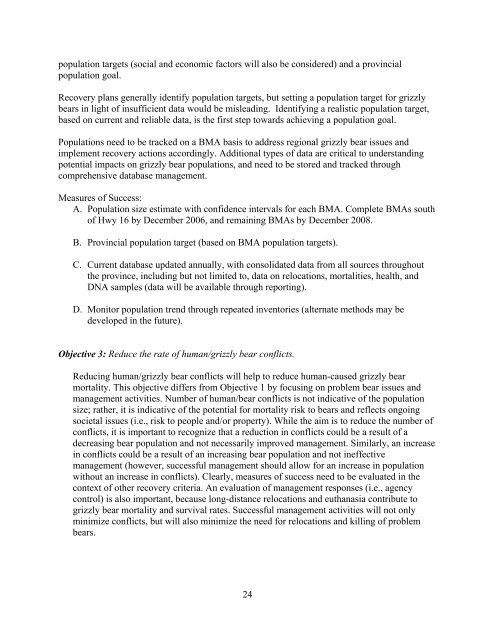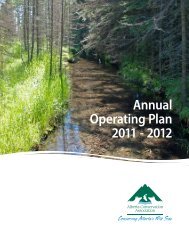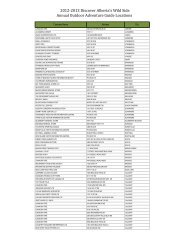Alberta Grizzly Bear Recovery Plan 2008-2013 - Alberta Sustainable ...
Alberta Grizzly Bear Recovery Plan 2008-2013 - Alberta Sustainable ...
Alberta Grizzly Bear Recovery Plan 2008-2013 - Alberta Sustainable ...
Create successful ePaper yourself
Turn your PDF publications into a flip-book with our unique Google optimized e-Paper software.
population targets (social and economic factors will also be considered) and a provincial<br />
population goal.<br />
<strong>Recovery</strong> plans generally identify population targets, but setting a population target for grizzly<br />
bears in light of insufficient data would be misleading. Identifying a realistic population target,<br />
based on current and reliable data, is the first step towards achieving a population goal.<br />
Populations need to be tracked on a BMA basis to address regional grizzly bear issues and<br />
implement recovery actions accordingly. Additional types of data are critical to understanding<br />
potential impacts on grizzly bear populations, and need to be stored and tracked through<br />
comprehensive database management.<br />
Measures of Success:<br />
A. Population size estimate with confidence intervals for each BMA. Complete BMAs south<br />
of Hwy 16 by December 2006, and remaining BMAs by December <strong>2008</strong>.<br />
B. Provincial population target (based on BMA population targets).<br />
C. Current database updated annually, with consolidated data from all sources throughout<br />
the province, including but not limited to, data on relocations, mortalities, health, and<br />
DNA samples (data will be available through reporting).<br />
D. Monitor population trend through repeated inventories (alternate methods may be<br />
developed in the future).<br />
Objective 3: Reduce the rate of human/grizzly bear conflicts.<br />
Reducing human/grizzly bear conflicts will help to reduce human-caused grizzly bear<br />
mortality. This objective differs from Objective 1 by focusing on problem bear issues and<br />
management activities. Number of human/bear conflicts is not indicative of the population<br />
size; rather, it is indicative of the potential for mortality risk to bears and reflects ongoing<br />
societal issues (i.e., risk to people and/or property). While the aim is to reduce the number of<br />
conflicts, it is important to recognize that a reduction in conflicts could be a result of a<br />
decreasing bear population and not necessarily improved management. Similarly, an increase<br />
in conflicts could be a result of an increasing bear population and not ineffective<br />
management (however, successful management should allow for an increase in population<br />
without an increase in conflicts). Clearly, measures of success need to be evaluated in the<br />
context of other recovery criteria. An evaluation of management responses (i.e., agency<br />
control) is also important, because long-distance relocations and euthanasia contribute to<br />
grizzly bear mortality and survival rates. Successful management activities will not only<br />
minimize conflicts, but will also minimize the need for relocations and killing of problem<br />
bears.<br />
24

















